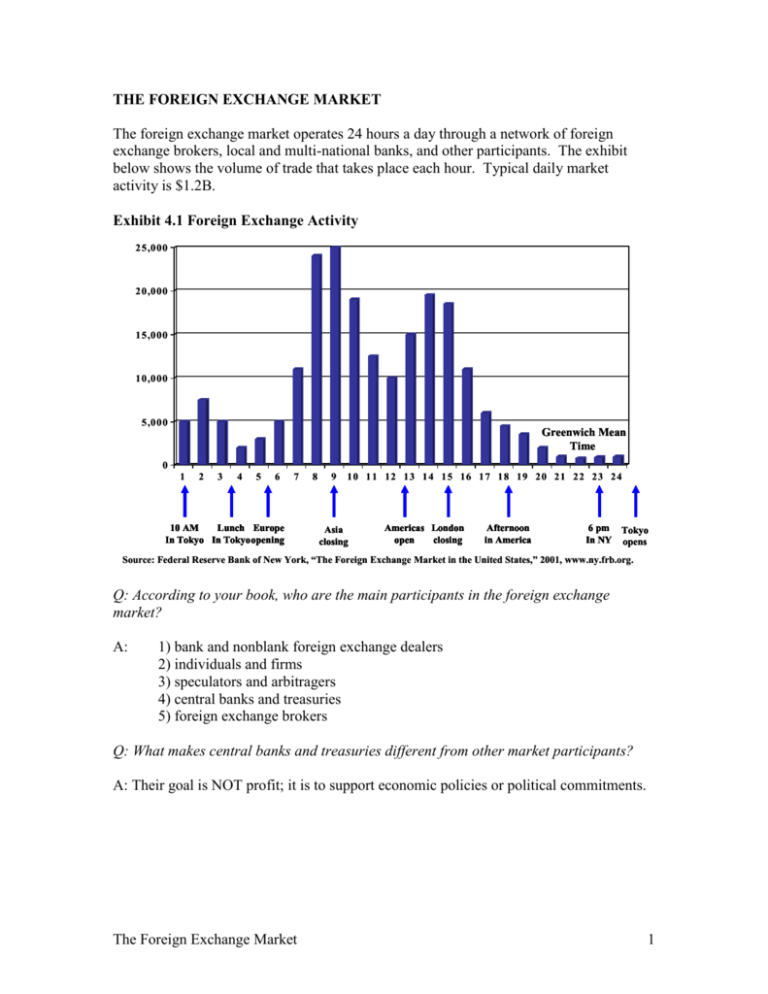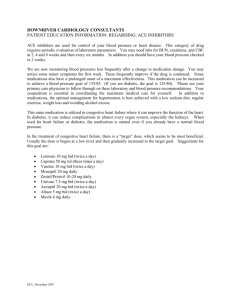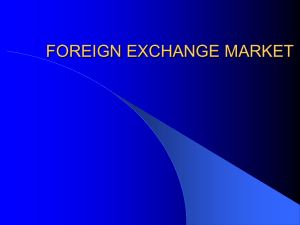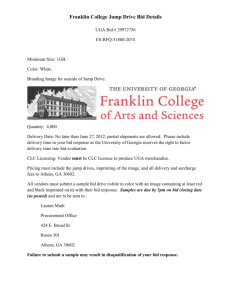THE FOREIGN EXCHANGE MARKET
advertisement

THE FOREIGN EXCHANGE MARKET The foreign exchange market operates 24 hours a day through a network of foreign exchange brokers, local and multi-national banks, and other participants. The exhibit below shows the volume of trade that takes place each hour. Typical daily market activity is $1.2B. Exhibit 4.1 Foreign Exchange Activity 25,000 20,000 15,000 10,000 5,000 Greenwich Mean Time 0 1 2 3 4 5 6 7 10 AM Lunch Europe In Tokyo In Tokyo opening 8 9 10 1 1 12 13 1 4 15 16 1 7 18 19 2 0 21 22 2 3 24 Asia closing Americas London open closing Afternoon in America 6 pm Tokyo In NY opens Source: Federal Reserve Bank of New York, “The Foreign Exchange Market in the United States,” 2001, www.ny.frb.org. Q: According to your book, who are the main participants in the foreign exchange market? A: 1) bank and nonblank foreign exchange dealers 2) individuals and firms 3) speculators and arbitragers 4) central banks and treasuries 5) foreign exchange brokers Q: What makes central banks and treasuries different from other market participants? A: Their goal is NOT profit; it is to support economic policies or political commitments. The Foreign Exchange Market 1 Two basic markets exist. 1) the spot currency exchange market and 2) the forward currency exchange market. The Spot Market Currencies trade for “immediate” delivery in the spot market (but settle 2 days after the trade date). Q: If the spot rate for Mexican pesos is Ps9.5200/$ and your company buys Ps100,000 spot from your bank on Monday, how much must your company pay and on what day? A: The company will pay Ps100,000 $10,504.20 on Wednesday. Ps9.52 / $ The Forward Market Currencies trade for future delivery. Standard forward contracts are for 30, 90, and 180 days after the trade date. Note “buying forward” and “selling forward” can be used to describe the same transaction. For example, 35G $ represents the six-month forward rate to buy Haitian gourde forward for U.S. dollars or the six month forward rate to sell U.S. dollars forward for Haitian gourde. A contract to deliver U.S. dollars for Haitian gourde in 6-months at F180 Review Direct Quotation – is the home currency price of a unit of foreign currency. For example, $0.50/ Bds$ is a direct quote for the U.S. dollar (as the home currency) and the Barbados dollar (as the foreign currency). This is also known as “American terms.” The Wall Street Journal uses this format for listing quotes under the heading “U.S.$ equivalent.” Indirect Quotation – the foreign currency price of a unit of home currency. For example, 1.99Bd$/$ is an indirect quote for the Barbados dollar (as the foreign currency) and the U.S. dollar (as the home currency). This is also known as “European terms.” The Wall Street Journal uses this format for listing quotes under the heading “Currency per U.S.$.” The Foreign Exchange Market 2 A Broker is an agent that facilitates trading between market participants. A broker charges a commission. A Dealer keeps an inventory of securities and stands willing to buy or sell at a given spread. A dealer makes money on the spread between the bid and the ask. (See below) Bid-Ask Quotes The bid is the price a dealer will buy a security. The ask is the price a dealer will sell a security. Bid = $22 A dealer’s profit comes from the spread between the bid and the ask. A customer will buy at the ask and sell at the bid. Ask = $22.5 A dealer’s spread is calculated as follows: ask bid spread x 100 ask Q: Assume an investor wants to invest $20,000 in Swiss securities. The exchange rates posted by four U.S. banks are as follows: Sfr/$ Sfr/$ Sfr/$ Sfr/$ Bank A Bank B Bank C Bank D 1.6357 – 72 1.6116 – 33 1.6261 – 80 1.6531 – 49 At which of these banks should the investor make the currency exchange? a. b. c. d. Bank A Bank B Bank C Bank D A: Choice “d” is correct. Exchange rates are generally quoted with the lower price the bank pays (the bid) on the left and the higher price at which they will sell (the ask) on the right. In this example Bank A will buy dollars for 1.6357 Swiss francs but will sell dollars at Sfr1.6372/$. The investor will be selling dollars, so the bank with the highest bid will be the target. In this example, Bank D has the highest bid for dollars at Sfr1.6531/$. The Foreign Exchange Market 3 Q: Assume that an investor has just received Sfr 25,000 and wants to obtain dollars for Francs. The exchange rates posted by four U.S. banks are as follows: Sfr/$ Sfr/$ Sfr/$ Sfr/$ Bank A Bank B Bank C Bank D 1.6357 – 72 1.6116 – 33 1.6261 – 80 1.6531 – 49 With which of the four banks should the investor deal? e. f. g. h. Bank A Bank B Bank C Bank D A: Choice “b” is correct. Exchange rates are generally quoted with the lower price the bank pays (the bid) on the left and the higher price at which they will sell (the ask) on the right. In this example, Bank A will buy dollars for 1.6357 Swiss francs but will sell dollars at Sfr1.6372/$. The investor will be buying dollars, so the bank with the lowest ask will be the target. In this example, Bank B has the lowest asking price for dollars at Sfr1.6133/$. Q: The exchange rates posted by four U.S. banks are as follows: Sfr/$ Sfr/$ Sfr/$ Sfr/$ Bank A Bank B Bank C Bank D 1.6357 – 72 1.6116 – 33 1.6261 – 80 1.6531 – 49 Remember the formula for a dealer’s spread is: spread ask bid x 100 ask Q: Compute the bid-asked spread for the following bond. Dealer I II III a. b. c. d. Bid 100 1/32 100 4/32 100 2/32 Ask 100 5/32 100 6/32 100 5/32 0.03125 0.0625 0.125 0.15625 A: The correct answer is “a.” Subtract the highest bid that you can sell from the lowest offer where you can buy. (100 5/32) – (100 4/32) = 1/32 = 0.03125 The Foreign Exchange Market 4 Forward Transactions – A forward transaction requires delivery at a future value date of a specified amount of one currency for a specified amount of another currency. Forward rates are usually quoted for value dates of one, two, three, six, and twelve months. Note: The exchange rate is established at the time of the agreement, but payment and delivery are not required until maturity. Note: Futures are exchange-traded agreements that call for future delivery of a standard amount of a currency (or other security or even commodity) at a fixed time, place, and price. Q: What are the three functions of the foreign exchange market? A: 1. To transfer purchasing power 2. To provide credit 3. To minimize foreign exchange risk Spot against a forward - buy currency in the spot market and sell the same amount back to the same bank in the forward market. Example: Bank A buys 10,000,000 Nicaraguan naira at today’s spot rate (~15.5nira/$) from Bank B + 10,000,000 nira - 645,161 dollars Bank A - 10,000,000 nira + 645,161 dollars Bank B and simultaneously sells 10,000,000 back to Bank B for dollars for delivery in 3 months (at the 3-month forward rate ~15.4nira/$). - 10,000,000 nira + 649,351 dollars Bank A + 10,000,000 nira - 649,351 dollars Bank B 0 nira - 4,189 dollars Bank A 0 nira + 4,189 dollars Bank B Bank A has in effect borrowed at the forward percent per year interest rate of 2.597%. Depending on the actual interest rates in 3 months, one party will “win” on this transaction. ff 15.5nira / $ 15.4nira / $ 360 x x 100 2.597% 15.4nira / $ 90 Note: the above formula is explained in detail later in these notes. The Foreign Exchange Market 5 Forward-forward swaps – The simultaneous purchase and sale of two forward contracts. Because of interest rate parity, the difference between the prices should be the interest rate differential. Example: A dealer sells ₤20,000,000 forward for dollars for delivery in 2 months at $1.6870/₤ and simultaneously buys ₤20,000,000 forward for delivery in three months at $1.6820/₤. T = 2 months T = 3 months -₤ 20,000,000 + ₤20,000,000 0 Dealer + $33,740,000 - $ 33,640,000 $100,000 Dealer To check the parity condition you can use the formula for the forward premium. ff £0.5928/$ £0.5945/$ 360 x x 100 3.557% £0.5945/$ 30 Essentially the dealer borrowed $33,740,000 and paid back $33,640,000; so for a onemonth loan the dealer paid 0.296% interest, which is 3.557% on an annual basis. $33,640,000 $33,740,000 x 100 0.296% x 12 3.557% $33,740,000 Cross rates – A “cross rate” is the exchange rate between two currencies implied by their value with respect to a third currency. Example: Given the following quotations: Dominican Republic pesos per U.S. dollar: RD$45.5/$ Colombian pesos per U.S. dollar: Col$2713.9/$ Find the exchange rate between the Dominican Republic peso and the Colombian peso. RD$ Col $ RD$ $ $ Col $ 45.5RD$ 2713.9Col $ 0.016766RD$ 59.646Col $ or $ $ Col $ RD$ Note: If the rates are given in different terms (i.e. indirect and direct quotes), then you can multiply the two exchange rates to get the third. RD$ $ RD$ x $ Col $ Col $ The Foreign Exchange Market 6 Q: Assume the following exchange rates for Mexican pesos and Netherlands guilders versus the U.S. dollar: Pesos/$ Guilders/$ 9.8700 2.3006 Based on this information, which of the following is the cross exchange rate between the pesos and the guilder, measured in pesos per guilder? a. b. c. d. P4.2902/G P0.2331/G P22.7069/G P4.3032/G A: Choice “a” is correct. The cross-exchange rate cancels out the common currency against which they were originally quoted. pesos pesos pesos dollar pesos $ x or guilders guilder dollar guilder guilder $ The Foreign Exchange Market 7 Cross Exchange Rates with Bid/Ask dealer spreads When calculating exchange rates with bid/ask spreads, use the relatively lowest rate for the currency you want to calculate the bid and the relatively highest exchange rate that you are looking for to calculate the ask. For example, if given the following quotes: ¥/$ 110 – 112 €/$ 1.05 – 1.06 If you want the bid/ask for the ¥/€. Step 1 Use the lowest quote for the yen which is ¥110/$ and multiply that by the lowest quote for the dollar which is 1.06€/$ which gives you the bid ¥103.7736/€. Step 2 Use the highest quote for the yen which is ¥112/$ and multiply that by the highest quote for the dollar which is 1.05€/$ which gives you the ask ¥106.6667/€. ¥ 110 /$ ¥112 /$ € 1.05 /$ € 1.06 /$ Q: Can wants to sell, by means of a 60-day forward contract, euros for Japanese yen to be delivered in Boston. The Boston dealers are quoting the following exchange rates of euros and yen against U.S. delivery. Spot: Forward (60 days) €/$ 0.9036 – 38 €/$ 0.9045 – 49 ¥/$ 100.61 – 91 ¥/$ 100.22 – 44 What is the yen/euro cross-rate in the spot market? a. b. c. d. 110.7526 – 110.9957 111.3189 – 111.6755 111.3435 – 111.6508 110.7526 – 111.0448 A: Choice “b” is correct. The bid calculation is ¥100.61/$ ¥111.3189/euro and the 0.9038euros/$ ¥100.91/$ ¥111.6755/euro . Note: Since the bid is the lower 0.9036euros/$ exchange rate and the ask is the higher exchange rate, the implied bid/ask spread is choice “b.” ask calculation is €0.9036 /$ €0.9038 /$ ¥100.61 /$ ¥100.91 /$ The Foreign Exchange Market 8 Triangular Arbitrage – Arbitrage among three currencies. Example: Bank A quote: $0.9045/€ (or 1.1056€/$) Bank B quote: $1.4443/₤ (or 0.6924₤/$) Bank C quote: €1.6200/₤ (or 0.6178₤/€) Note: these are “bid” quotes Remember: the “bid” is lower than the “ask” Based on the cross rate relationship, the exchange rate for the €/₤ should be: 1.1056euros 0.6924£ 1.5968euros $ $ £ Since Bank C quotes the exchange rate as €1.6200/₤, an arbitrage opportunity exists. The following three steps illustrate how to profit from this disparity. Step 1 – Sell $1,000,000 to Bank B at $1.4443/₤ (Receive ₤692,377) £0.692377 $1,000,000 x £692,377 $ Step 2 – Sell ₤692,377 to Bank C at €1.6200/₤ (Receive €1,121,651) 1.620euros £692,377 x 1,121,651euros £ Step 3 – Sell €1,121,651 to Bank A at $0.9045/€ (Receive $1,014,533) $0.9045 1,121,651euros x $1, 014,533 euros Alternatively, Step 1 – Sell €1,000,000 to Bank A at $0.9045/€ (Receive $904,500) $0.9045 1,000,000euros x $904,500 euros Step 2 – Sell $904,500 to Bank B at $1.4443/₤ (Receive ₤626,255) £0.692377 $904,500 x £626,255 $ Step 3 – Sell ₤626,255 to Bank C at €1.6200/₤ (Receive €1,014,533) £0.6178 1,465,290euros x £904,500 euros The Foreign Exchange Market 9 Forward percent per year premium/discount formula (Indirect Quotations): Remember: an indirect quote is foreign/domestic. f f Spot Forward 360 x x 100 Forward n Example: Suppose the spot rate for the Brazilian real is 2.932R$/$ and the 3-month forward rate is 2.9R$/$. What is the percent per year premium (or discount) for the real? 2.932R$ / $ 2.9 R$ / $ 360 x x 100 4.41% 2.9R$ / $ 90 ff The forward real is selling at a 4.41% per year premium to the dollar. Q: The nine-month forward exchange rate between the U.S. dollar and the euro is $0.96/€. The spot exchange rate is $0.94/€. What is the forward premium on the euro? A: The forward premium for the euro is: ff 1.06euro / $ 1.04euro / $ 360 x x 100 2.84% 1.04euro / $ 270 Spot exchange rate changes formula (Indirect Quotations): % Beginning rate Ending rate x 100 Ending rate Example: Suppose the spot rate for the Brazilian real is 2.932R$/$ on Monday and increases to 3R$/$ on Friday. What is the percent change in the spot rate for the real? % 2.932R$ / $ 3R$ / $ x 100 2.267% 3R$ / $ The Brazilian real depreciated by 2.267% from Monday to Friday. The Foreign Exchange Market 10 Final Project Session 1 The World Factbook: http://www.cia.gov/cia/publications/factbook/index.html Potential value drivers (destroyers) Chapter 1 Session 2 The World Bank: http://www.worldbank.org/data/countrydata/countrydata.html Resources for Finance Courses Session 1 www.investopedia.com Resources for your Career Session 1 LIFA Exam: www.the-ira.org CFA Exam: www.cfainstitute.org Session 2 www.jobsinthemoney.com Practice Homework Problems Chapter 1 – Question 1 & 2 Chapter 2 – Problems 1 & 8 Chapter 3 – Questions 2-5 & 10 a, b, e, s, t and Problems 1-4 Chapter 4 – Problems 2-5 Chapter 5 – Problems 2 & 11 Chapter 6 – Problems 2 & 3 Chapter 7 – Problems 1 – 10 Chapter 14 – Problems 1 & 2 The midterm on September 12th will cover these chapters. The Foreign Exchange Market 11 Project Proposals are due next week! Project Proposals Your project proposals are due by the date noted in the syllabus (before 4:30pm). You will loose 5 points for turning it in after 4:30pm and 10 points for turning it in after 7pm. (You will loose 50 points for turning it in after the date noted in the syllabus, and your team will be required to meet with me outside of class.) Your project proposal is worth 10% of your final project grade. Of course I will happily accept your project proposals early! What it should include: Team members’ names (each team should have 4-5 members), e-mails, and phone numbers. (This is a good way to make sure each of you can get in contact throughout the semester.) Also, let me know who your designated team leader is, your chosen country (or countries), and the two different industries or companies you want to invest in. I want my copy to be signed by all team members. You will be graded on professionalism (no typos), overall appearance, completeness (all contact info, signatures, and required information), timeliness, and preparation (your reasons for choosing your country and industries/companies). Finally, your project proposals should be no more than 1 page. I have already heard some exciting ideas, and I am already looking forward to your final projects! The Foreign Exchange Market 12







